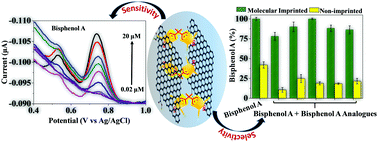Selective electrochemical detection of bisphenol A using a molecularly imprinted polymer nanocomposite†
Abstract
Bisphenol A is the most common endocrine disrupting chemical found in the environment and human exposure to it leads to a variety of health issues. Thus detection and removal of bisphenol A from industrial waste/soil/drinking water are critical to minimize human consumption. Here we report a molecularly imprinted nanocomposite for selective electrochemical detection of bisphenol A. The nanocomposite has covalently connected polyacrylate, β-cyclodextrin and reduced graphene oxide components with the molecular imprints of bisphenol A for its selective capture via host–guest complexation with β-cyclodextrin. Bisphenol A can be selectively detected in the presence of various bisphenol A analogues via an electrochemical approach where the reduced graphene oxide component induces electrocatalysis. The linear concentration range of bisphenol A detection is 0.02–1.0 μM with a limit of detection (LOD) of 8 nM. This approach has been used for the detection of bisphenol A in contaminated water and may be extended to the detection of bisphenol A among other natural contaminants.



 Please wait while we load your content...
Please wait while we load your content...